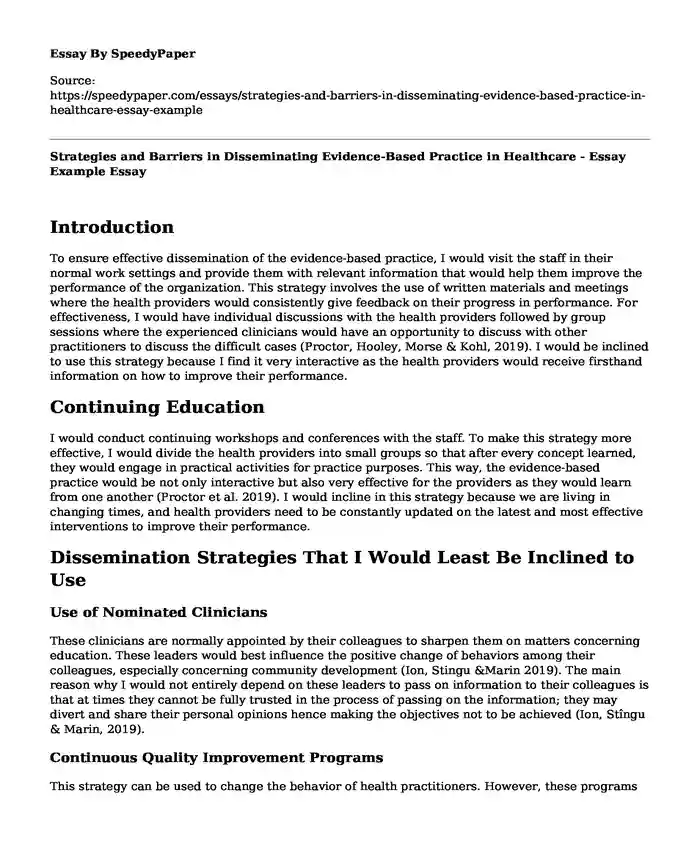
| Type of paper: | Essay |
| Categories: | Strategy Education Health and Social Care |
| Pages: | 3 |
| Wordcount: | 678 words |
Introduction
To ensure effective dissemination of the evidence-based practice, I would visit the staff in their normal work settings and provide them with relevant information that would help them improve the performance of the organization. This strategy involves the use of written materials and meetings where the health providers would consistently give feedback on their progress in performance. For effectiveness, I would have individual discussions with the health providers followed by group sessions where the experienced clinicians would have an opportunity to discuss with other practitioners to discuss the difficult cases (Proctor, Hooley, Morse & Kohl, 2019). I would be inclined to use this strategy because I find it very interactive as the health providers would receive firsthand information on how to improve their performance.
Continuing Education
I would conduct continuing workshops and conferences with the staff. To make this strategy more effective, I would divide the health providers into small groups so that after every concept learned, they would engage in practical activities for practice purposes. This way, the evidence-based practice would be not only interactive but also very effective for the providers as they would learn from one another (Proctor et al. 2019). I would incline in this strategy because we are living in changing times, and health providers need to be constantly updated on the latest and most effective interventions to improve their performance.
Dissemination Strategies That I Would Least Be Inclined to Use
Use of Nominated Clinicians
These clinicians are normally appointed by their colleagues to sharpen them on matters concerning education. These leaders would best influence the positive change of behaviors among their colleagues, especially concerning community development (Ion, Stingu &Marin 2019). The main reason why I would not entirely depend on these leaders to pass on information to their colleagues is that at times they cannot be fully trusted in the process of passing on the information; they may divert and share their personal opinions hence making the objectives not to be achieved (Ion, Stîngu & Marin, 2019).
Continuous Quality Improvement Programs
This strategy can be used to change the behavior of health practitioners. However, these programs only improve their administration skills but not clinical service (Frederiksen, 2019). I would least use this stage because these programs might not be fully controlled by the kind of information that is passed on; this means that my objective of disseminating the evidence-based practice would not be achieved fully.
Barriers
Lack of resources is the first barrier that is likely to be encountered. For educational outreach visits to be effective, resources such as money and time should be availed (Magdalinou, Mantas, Montandon, Weber & Gallos, 2019). For example, quality time must be allocated for small group activities to apply the learned concepts effectively. The second barrier I am likely to encounter is a Lack of dissemination skills to implement the continuing education strategy. Conducting continuing skills without skills would bear no fruit in improving the performance of health providers.
How to Overcome the barriers
I would overcome the barrier of lack of resources and dissemination skills by encouraging researchers to get involved in -country dissemination actions. I would also make sure I allocate enough project time towards consultations where all the key stakeholders would deliberate on how to solve evidence-based problems.
References
Frederiksen, S. (2019). Hospital Social Workers and Evidence-Based Practice (Doctoral dissertation). http://hdl.handle.net/11375/24340
Ion, G., Stîngu, M., & Marin, E. (2019). How can researchers facilitate the utilisation of research by policy-makers and practitioners in education? Research Papers in Education, 34(4), 483-498. https://doi.org/10.1080/02671522.2018.1452965
Magdalinou, A., Mantas, J., Montandon, L., Weber, P., & Gallos, P. (2019). Disseminating Research Outputs: The CrowdHEALTH Project. Acta informatica medica : AIM : journal of the Society for Medical Informatics of Bosnia & Herzegovina : casopis Drustva za medicinsku informatiku BiH, 27(5), 348–354. https://doi.org/10.5455/aim.2019.27.348-354
Proctor, E., Hooley, C., Morse, A., McCrary, S., Kim, H., & Kohl, P. L. (2019). Intermediary/purveyor organizations for evidence-based interventions in the US child mental health: characteristics and implementation strategies. Implementation Science, 14(1), 3. https://doi.org/10.1186/s13012-018-0845-3
Cite this page
Strategies and Barriers in Disseminating Evidence-Based Practice in Healthcare - Essay Example. (2023, Nov 05). Retrieved from https://speedypaper.net/essays/strategies-and-barriers-in-disseminating-evidence-based-practice-in-healthcare-essay-example
Request Removal
If you are the original author of this essay and no longer wish to have it published on the SpeedyPaper website, please click below to request its removal:
- Marketing Essay Sample - Pricing Strategy
- Essay Sample on Nursing Theories: Case Study
- Free Essay: Benchmark - Ethical Dilemma
- Free Essay Sample: Sports Finance
- Prostate Cancer: Early Detection Can Save Lives - Essay Sample
- Paper on Educational Evolution: Unveiling the Internet's Influence on Learning and the Ascendance of E-Learning
- Chronic Diseases and Mental Illnesses are Different - Paper Example
Popular categories




